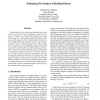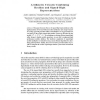199 search results - page 3 / 40 » The Residue Logarithmic Number System: Theory and Implementa... |
HASE
1998
IEEE
13 years 10 months ago
1998
IEEE
Residual defects is one of the most important factors that allow one to decide if a piece of software is ready to be released. In theory, one can find all the defects and count th...
INTEGRATION
2008
13 years 5 months ago
2008
Abstract: Hybrid-redundant number representation has provided a flexible framework for digitparallel addition in a manner that facilitates area-time tradeoffs for VLSI implementati...
ICML
1995
IEEE
14 years 6 months ago
1995
IEEE
A number of reinforcement learning algorithms have been developed that are guaranteed to converge to the optimal solution when used with lookup tables. It is shown, however, that ...
CORR
2010
Springer
13 years 5 months ago
2010
Springer
The problem of distributed learning and channel access is considered in a cognitive network with multiple secondary users. The availability statistics of the channels are initially...
APCSAC
2003
IEEE
13 years 11 months ago
2003
IEEE
This paper discusses the use of signed-digit representations in the implementation of fast and efficient residue-arithmetic units. Improvements to existing signed-digit modulo adde...


